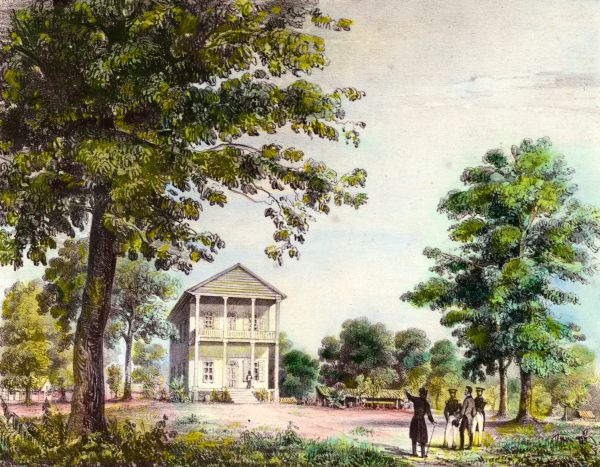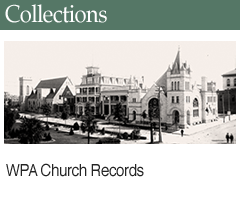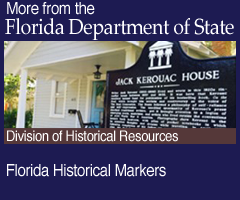A Guide to Researching the Territorial Era
at the State Archives of Florida

War & Military Affairs
From its inception, the government of the Territory of Florida provided for a militia. The Governor served as commander-in-chief, with the authority to appoint and remove officers.
The most challenging episode of the territorial militia's tenure was its involvement in the Second Seminole War (1835-1842). Almost immediately after Florida became a United States possession, federal and territorial officials began negotiating with the Seminoles, hoping to induce them to relocate farther down the peninsula. Several plans to resettle the natives fell through, and by the 1830s clashes between Seminoles and white settlers were on the rise. A series of skirmishes in late 1835 elevated the conflict to all-out war. In the fighting that ensued, militia and regular troops alike fought the Seminoles, many casualties being inflicted on both sides. Over 3,800 Seminoles were transported to reservations in the West, some voluntarily and many others against their will. A handful of Seminoles remained in the territory, confined to the extreme southern reaches of the peninsula.
The records in this section mainly document the business of Florida's territorial militia, although a few of the records touch on Floridians' involvement with the U.S. military. Documents relating to the Armed Occupation Act are included in this section as well.
This guide provides the name and a description of each collection or series, plus its identification number, which is hyperlinked to its record in the Archives Online Catalog. Once inside the catalog record, you can access a list of the volumes, boxes or folders that make up the collection or series.
Series 43: Territorial and State Military Expenditures, 1839-1869
The series consists of the Comptroller's Office records for territorial and state military expenditures from 1839 to 1869. The series contains the expenditure records for territorial militia companies, frontier guard units of Seminole Indian wars, Confederate military organizations and local guard activities. The records include invoices, receipts, provision records, vouchers, payrolls and requisitions for forage. These records provide information on some Florida military units not available elsewhere.
The records are subdivided into (1) Territorial military expenditure records, arranged by record type, and then chronologically; (2) Statehood military expenditure records, arranged by record type, and then chronologically; and (3) Payroll for officers, arranged alphabetically by unit.
Series 608: Compiled Service Records of Volunteer Soldiers from Florida Units – Florida Indian Wars, 1835-1858
These compiled service records represent volunteers from Florida units that served during the Creek War, Second Seminole War, and Third Seminole War. These wars resulted from attempts to relocate Indian nations from the Southeastern United States to land west of the Mississippi River.
The participation of Florida volunteers in the Creek War was limited. Only one unit, the 5th Florida Militia, was mustered into service. The regiment had 32 men, served for only 11 days (February 23-March 5, 1839) and saw no action.
The Second Seminole War (1835-1842) was the longest and most costly Indian war within the State. It has been estimated that approximately 42,000 men from Florida and neighboring states were mustered into volunteer organizations over the course of the conflict.
The third Seminole war (1855-1858) was a recurrence of hostilities created by the policy of Indian relocation. This conflict began with the ambush of an 11-man U.S. Engineer survey party on December 20, 1855, in the "Big Cypress Swamp." By January of 1856, six companies of volunteers had been raised primarily from three Florida counties: Hernando, Hillsborough and Manatee. By March 1856, Federal troops had entered the dispute and had begun to outnumber the volunteers. Approximately 700 Florida volunteers had been mustered into service by the end of the Third Seminole War.
This microfilm publication contains the compiled service records of volunteer soldiers who served in Florida organizations during a series of disturbances known as the Florida Indian wars. A typical compiled service record consists of a jacket-envelope containing card abstracts of entries relating to a soldier as found on original regimental returns and muster rolls. There are also jacket-envelopes used as cross-references for the names of Volunteers that appear in the records under more than one spelling.
Card abstracts for an individual soldier in any Florida Volunteer organization usually show his rank, the unit in which he served, term of service, time and place of enlistment and promotions or demotions received. In certain organizations, information may be found regarding his activities within the unit, dates of leave (either official or unofficial), illnesses and death. If a soldier was a member of a mounted organization, the abstracts also show the value of his mount and his equipment.
Most units possess compiled records, and these consist of either caption or record-of-events cards contained in jacket-envelopes. Captain cards include information on when, where and under whom the unit operated, and often bear a copy of certification and endorsement found in the original records.
In a few cases what is essentially one unit is listed more than once in the table of contents. This reflects the fact that the unit was reorganized on one or more occasions, and that each new formation was treated as a separate unit for records compilation, even though the old name and number did not change. Sometimes the year a new formation was organized was included, making it easier to distinguish one formation from another. For example, the records for the third Seminole war include "Bullock's Company, Florida Mounted Volunteers, 6 months, 1856-1857" and "Bullock's Company, Florida Mounted Volunteers, 6 months, 1857."
Series 1274: Military Election Returns by County, 1824-1865
This series contains the surviving Florida territorial and state militia officer election records for the period 1824 to 1865. County election records were sent to Tallahassee for recording and preservation by the Secretary of the Territory and the Secretary of State's office.
Most of the pre-1860s returns were handwritten and included the name of the county, the unit or "beat," the names of candidates, the positions being filled, the number and distribution of votes cast, and statements certifying the validity and legality of the election results. At one time or another all militia offices from Major General to Subaltern were filled by election. Not every year of the inclusive span is present for any county. Most records are clustered in the 1830s and 1840s with a few in the 1820s, 1850s and 1860s.
Also included is a canvass of election returns dated April 6, 1845. It provides the totals for the general officers and field officers for the Third Division, Third and Fourth Brigades, and the Ninth through Twelfth Regiments.
Series 1277: Original Florida Territorial Muster Rolls, 1826-1849
The first state militia companies were organized under the Florida Militia Law of 1822, adopted shortly after the American acquisition of Florida. There were actually two separate types of militia during this period. One was the enrolled militia, consisting of all able-bodied, free white males between the ages of 18 and 45. Theoretically, these men were assigned to units and required to drill at least four times a year. The enrolled militia was unwieldy, with a complicated administrative hierarchy and few units progressed beyond the planning stage.
The independent volunteer companies were a more successful type of militia. Organized and commanded locally, these units were generally better trained and prepared for emergency use. In practice, they proved more valuable than the unorganized, "enrolled" militia.
This series contains original Florida territorial muster rolls for the Florida State Militia units from 1826 to 1849. The surviving territorial rolls include several from the 1820s organizational period, while the majority date from the Second Seminole War (1835-1842). One post-Territorial muster roll is contained in this series; it dates from 1849. In most instances the rolls contain the name and rank of the soldier, when and where they were enrolled and remarks. An abstract of the annual strength return for 1845 has also been included in this series. Some of the records are barely legible.
Series 1281: Seminole War Muster Rolls – Florida Militia, 1836-1841, 1856-1858
Note: The Seminole War muster rolls of the Florida militia have been transcribed by the Florida Department of Military Affairs and are available from the State Library of Florida.
The volumes contain photostatic copies of muster rolls for Florida militia volunteer units for the Second and Third Seminole Wars from 1836 to 1841 and 1856 to 1858. The rolls list the name, age, and rank of the soldier, the date and place of enlistment, information regarding pay and general remarks. The majority of these units are independent companies that may have served in more than one period of any or all of the three wars. The date listed in the index is the date of the latest muster roll for the unit concerned. Most volunteer and militia companies were known by the commander's name, e.g. Smith's Company of Mounted Volunteers. The alphabetical arrangement of the names is not kept in strict order throughout the volumes.
Series 1305: Armed Occupation Act Permit Files – Florida District, U.S. General Land Office, 1842-1843
Note: The Armed Occupation Act Permit Files have been digitized by the Florida Department of Environmental Protection, Division of State Lands as part of its land document database. Choose "AOP" in the Document Type field in this database to search the permit applications.
The Florida Armed Occupation Act of 1842 (5 U.S. Statutes 502) was passed to encourage the settlement of Florida. The Florida District General Land Offices were responsible for the handling of claims made under this Act. The Act granted 160 acres of unsettled land south of the line separating townships 9 and 10 South (a line running East/West about three miles north of Palatka and about 10 miles south of Newnansville) to any head of a family under three conditions: (1) the land selected could not be within two miles of a military post; (2) the settler must be able to bear arms and live on the land for five years; and (3) the settler must clear five acres and build a house.
This series contains microfilm copies of the applications for permits to settle under the conditions of the Florida Armed Occupation Act of 1842 from 1842 to 1843. The permits were filed at the Saint Augustine and Newnansville Federal District Land Office. It should be noted that the applications include when the applicant became a resident of Florida. Also included in the series are notices, refusals and acceptances, and correspondence pertaining to the claims and permits issued.
Series 1414: Reports of the U.S. Treasury Department concerning Claims resulting from the Florida Indian Wars, 1824-1859
This microfilm collection contains reports and lists concerning the claims of citizens and soldiers/militiamen resulting from U.S. government actions against the Seminoles in the first half of the nineteenth century.
The originals are held by the National Archives in Washington, D.C.
Collection M86-12: Thomas Sidney Jesup Diary, 1836-1837
Note: The Thomas Sidney Jesup diary has been digitized in its entirety and is available for viewing on Florida Memory.
General Thomas Sidney Jesup (1788-1860) was the third general to command Florida troops during the Second Seminole War. Jesup, a career military man, served 18 years as Quartermaster General before President Andrew Jackson called him to active duty during the Indian Wars.
The collection consists of the campaign diary of General Jesup while commanding his first campaign of the Second Seminole War from October 1, 1836 to May 30, 1837. The diary details the routine of a commander issuing orders, requisitioning supplies and directing troop movement. It also documents the relationship between the regular army and the state militia and communications with the Seminole Indians. The diary also reflects the hardships and problems encountered by Jesup and his men in locating the elusive Seminoles in the extensive Florida wilderness.

 Listen: The Blues Program
Listen: The Blues Program


